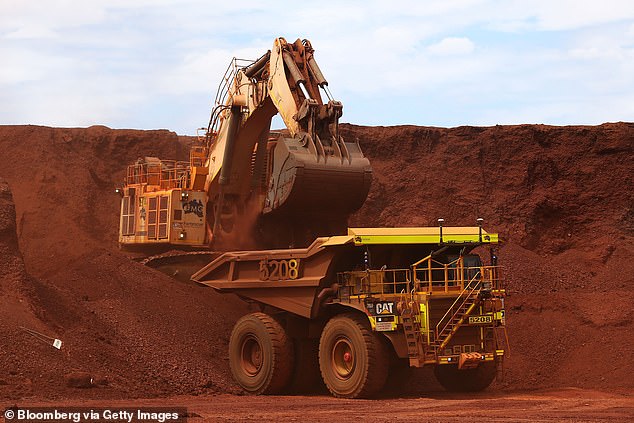Iron ore to China: crushing blow to Australian economy as our biggest export halves in value

- Iron ore prices expected to decline through 2025
The price of Australia’s biggest export is expected to continue falling, depriving governments of much-needed revenue during an economic recession.
Iron ore, which is used to make steel, was by far Australia’s biggest export last year, worth $136 billion, thanks to insatiable demand from China.
The Pilbara region of Western Australia supplied 38 percent of the world’s iron ore and two-thirds of China’s iron ore came from there.
But the bursting of China’s property bubble is likely to send iron ore prices down even further than they have since early 2024.
Apartment giant Evergrande was liquidated by a Hong Kong court earlier this year, and Country Garden, another mega-apartment developer, faces a similar fate.
According to Diana Mousina, deputy chief economist at AMP, iron ore prices could fall further if Chinese investors in the stock market become nervous, as worse risk sentiment would impact the prices of key commodities.
“The risk is more about financial contagion than steel demand,” she told Daily Mail Australia.
“It depends on whether there is an expectation that global growth will slow. Normally commodity prices fluctuate in combination with the expected demand for them. You can see that very clearly in things like oil prices and even iron ore.”

The price of Australia’s largest export is expected to continue falling, depriving governments of much-needed revenue during an economic recession (pictured is a Fortescue mine in the Pilbara)
Iron ore prices, including costs and freight, have fallen from $144 a tonne in January to just $100 this week.
That 31 percent drop is expected to soon exceed 50 percent. Western Australian Treasury officials expect the price to fall to $71 by November this year, which represents the long-term average.
The state’s May budget forecast iron ore royalty revenues would fall by more than a third to $6.329 billion in 2024-25, down from $9.850 billion in 2023-24.
The drop in iron ore prices would also cost the federal government $3 billion in revenue, forcing cuts or further increasing the national debt.
The May budget forecast that iron ore prices would almost halve to just $60 a tonne by the third quarter of 2025, down from then-current prices of more than $100 a tonne.
“I do think there is some downside risk to iron ore prices, but for the price to fall to $60 a tonne, the Chinese economy would have to weaken much further,” Mousina said.
‘We have seen a number of announcements from Chinese companies that iron ore prices are likely to be lower due to lower demand for steel and lower infrastructure needs, both in the property market and more broadly in the economy.’
Every $US10 per tonne drop in the iron ore price equates to a loss of $500 million in government revenue.
Canberra quotes the freight price on board, without taking into account the transport costs. In contrast, the Western Australian government quotes the cost price and the freight price, which is usually around $10 per tonne higher.
The bad news comes amid a severe economic slowdown, with the Australian economy growing by just 1 percent in the year to June, the slowest non-pandemic growth rate since the 1991 recession.

Apartment giant Evergrande (apartments in Hebei province, pictured) was liquidated earlier this year by order of a Hong Kong court, and Country Garden, another mega-apartment developer, faces a similar fate
The fall in iron ore prices also means Australia is facing wider current account deficits.
From mid-2019 to the end of 2023, Australia ran a current account deficit for only two quarters, but that was during a period when China was still consuming large amounts of steel to build residential towers.
Australia enjoyed consecutive current account surpluses for the first time since the early 1970s, but that changed in early 2024.
But Mousina said iron ore prices may not fall as far as feared as there is still demand for steel in the manufacturing sector to offset losses from falling demand for real estate.
“The housing market there is extremely bad and we are going through very difficult times, with low home sales and negative house price growth,” she said.
“But parts of the manufacturing industry are still quite strong.”




